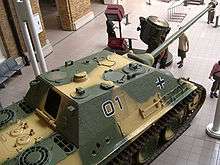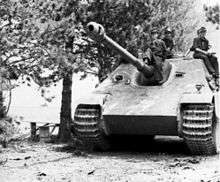Jagdpanther
| Jagdpanther | |
|---|---|
|
Jagdpanzer V Jagdpanther | |
| Type | Tank destroyer |
| Place of origin | Nazi Germany |
| Service history | |
| In service |
1944-1945 (Nazi Germany) 1945-1960s (France) |
| Production history | |
| Produced | 1944–1945 |
| Number built | 415 |
| Variants | G1, G2 |
| Specifications | |
| Weight | 45.5 tonnes (100,300 lb) |
| Length | 9.87 m (32 ft 5 in) |
| Width | 3.42 m (11 ft 3 in) |
| Height | 2.71 m (8 ft 11 in) |
| Crew | 5 |
|
| |
| Armor |
80 mm (3.14 in) frontal 100 mm (3.93 in) mantlet 60mm side 40mm rear |
Main armament |
1 × 8.8 cm Pak 43/3 or 43/4 L/71 57 rounds |
Secondary armament |
1 × 7.92 mm Maschinengewehr 34 600 rounds |
| Engine |
Maybach HL230 P30 (V-12 petrol) 700 PS (690 hp, 515 kW) |
| Power/weight | 15.4 PS (11.3 kW) / tonne |
| Suspension | dual torsion bar |
Operational range | 160 km (99 miles) |
| Speed | 46 km/h (28.6 mph) |
The Jagdpanther (German: "hunting panther") was a tank destroyer built by Nazi Germany during World War II based on the chassis of the Panther tank. It entered service late in the war (1944) and saw service on the Eastern and Western Fronts. The Jagdpanther combined the very powerful 8.8 cm KwK 43 cannon of the Tiger II and the characteristically excellent armor and suspension of the Panther chassis,[1] although it suffered from the general poor state of German ordnance production, maintenance and training in the later part of the war, which resulted in small production numbers, shortage in spare parts and poor crew readiness.
Development
The Jagdpanther had been preceded by two attempts at mounting an 8.8 cm gun as a self-propelled anti-tank weapon; Ferdinand using the 91 leftover Porsche-built VK4501(P) chassis from the Tiger tank competition it had lost to Henschel in 1942, and the Nashorn using a Panzer III/IV chassis. Ferdinand proved to be too heavy and Nashorn small and underpowered.[2]
A heavy tank destroyer design based on the 8.8 cm Pak 43 gun and the Panther tank chassis was ordered in late 1942 as design SdKfz 173. The prototype by Mühlenbau-Industrie A.G. (MIAG) was demonstrated in October 1943 before Hitler.
Production started in January 1944; in February Hitler specified the simpler Jagdpanther name instead of its original "8.8 cm Pak 43/3 auf Panzerjäger Panther".

To accommodate the heavier-calibre gun, much as on previous Jagdpanzer-style unturreted tank destroyers, the glacis plate and sloped hull sides of the Jagdpanther were extended up into an integral, turretless fixed casemate as part of the main hull itself to provide a roomy interior. The Jagdpanther had side armour of increased thickness (60 mm) to offset the slightly reduced angle of the side armour necessary to provide enough interior space. Frontal armour was 80mm. The new (April 1944) Panther Ausf. G had the same feature, to harmonize production and increase protection.
It was armed with the same long-barreled 8.8 cm gun as the Tiger II "King Tiger". The gun was mounted in a central mantlet, which gave it a limited traverse of 11 degrees to each side. A single 7.92 mm MG-34 machine gun for local defence was in a ball mount on the right side of the front glacis plate. The machine gunner was also the wireless operator. The driver sat on the left. The gunner had a rangefinder and a periscope telescopic sight. The periscope - linked to the gun mount - was under an armoured housing on the roof.
The Jagdpanther had a good power-to-weight ratio and a powerful main gun, which enabled it to destroy any type of Allied tank. Based on the existing Panther Ausf G chassis, the vehicle did not suffer too many mechanical problems. It had an upgraded transmission (the ZF AK 7-400 heavy duty) - which had been planned for the Panther II - and final drive to counter the Panther's main weakness. It was manned by a crew of five: a driver, radio-operator, commander, gunner and a loader.[3]

Two main variants can be distinguished, the earlier (1944 model) G1 with a small internally bolted main gun mantlet and a modified Panther A engine deck, and the later (1945 model) G2 with a larger simplified, outside-bolted mantlet and a modified Panther G engine deck, though late G1s also had the larger mantlet. Early Jagdpanthers had two vision openings for the driver, whereas late versions had only one. The main gun originally had a monobloc gun barrel, but later versions were equipped with the Pak 43/4 gun with a two-part barrel. The two part barrel was more economical as barrel wear was not even.[3]
Early G1s (to September 1944) were given Zimmerit anti-magnetic mine coating in a distinctive "small-squared" pattern.
Production and service
A total of 415 Jagdpanthers were produced from January 1944 by three manufacturers. MIAG produced 270 from January 1944 until the end of the war. Maschinenfabrik Niedersachsen-Hannover (MNH) produced 112 from November 1944. Maschinenbau und Bahnbedarf (MBA) produced 37 vehicles from December 1944.[4] Planned production had been 150 a month, but the disruption to German manufacturing had made this impossible.[3]
Jagdpanthers equipped heavy antitank battalions (schwere Panzerjäger-Abteilung) and served mainly on the Eastern Front.[1] In the West, they were first encountered in very small numbers late in the Battle of Normandy, where the German 654 schwere Panzerjäger-Abteilung ("654th Heavy Antitank Battalion") deployed about 12 Jagdpanthers against British units. Later, significant numbers were concentrated in the West for the Ardennes Offensive.
Survivors

Three surviving Jagdpanthers have been restored to running condition. Two German museums, the Deutsches Panzermuseum at Munster and the Wehrtechnische Studiensammlung (WTS) at Koblenz, each have a running Jagdpanther. The SDKFZ Foundation in the UK has restored one Jagdpanther to running condition, using two wrecked Jagdpanthers to complete one. The other wreck will also be restored.
There are at present seven other known surviving Jagdpanthers, which are on display at:
- Bovington Tank Museum, Dorset, UK—one of a number assembled by British Army Royal Electrical and Mechanical Engineers for trials, late production model.[5]
- Imperial War Museum Duxford, Duxford, UK. Early production variant. This has three shot penetrations on the right side of the engine compartment while the left side has been sectioned and opened to public view. Was hit during the battle of Hechtel, Belgium by Hugh Griffiths, Baron Griffiths [6]
- Kubinka Tank Museum, Moscow, Russia
- Musée des Blindés in Saumur, France
- Sinsheim Auto & Technik Museum, Sinsheim, Germany
- Panzermuseum Thun, Thun, Switzerland
- United States Army Ordnance Museum, Aberdeen, USA - moved to Virginia
- The Wheatcroft Collection in the UK owns a small collection of parts of Jagdpanthers and hopes to restore one.[7]
Media appearances
- The 1950 film They Were Not Divided (1950) features a Jagdpanther.
- One can be seen in It Happened Here (1965)
- The HBO miniseries Band of Brothers, episodes "Carentan" and "Replacements" feature a replica Jagdpanther which had been built on a Soviet T-55 tank chassis.
See also
Notes
- 1 2 Higgins, David R. (2014). Jagdpanther vs SU-100. Eastern Front 1945. Osprey Publishing.
- ↑ AFV Profile No. 10 p17
- 1 2 3 AFV Profile No 10 p19.
- ↑ Spielberger, p. 196
- ↑ "Accession record for Museum collection".
- ↑ Imperial War Museum. "Sd Kfz 173 Jagdpanther (Tank Destoyer [sic])". Imperial War Museum Collections Search. Retrieved 17 February 2012.
- ↑ http://www.wheatcroftcollection.com/home.html.
References
- Spielberger, Walter, Panther & Its Variants, 1993. ISBN 0-88740-397-2
- Chris Ellis & Peter Chamberlain, AFV Profile No. 10 - Panzerkampfwagen V Panther Profile Publications.
External links
- "Jagdpanther". AFV Database. Archived from the original on 28 December 2012.
- Information about the Jagdpanther at Panzerworld
- Achtung Panzer!
- Panthers survivors—A PDF file presenting the Panther tanks (Panther, Jagdpanther, Bergepanther) still surviving

